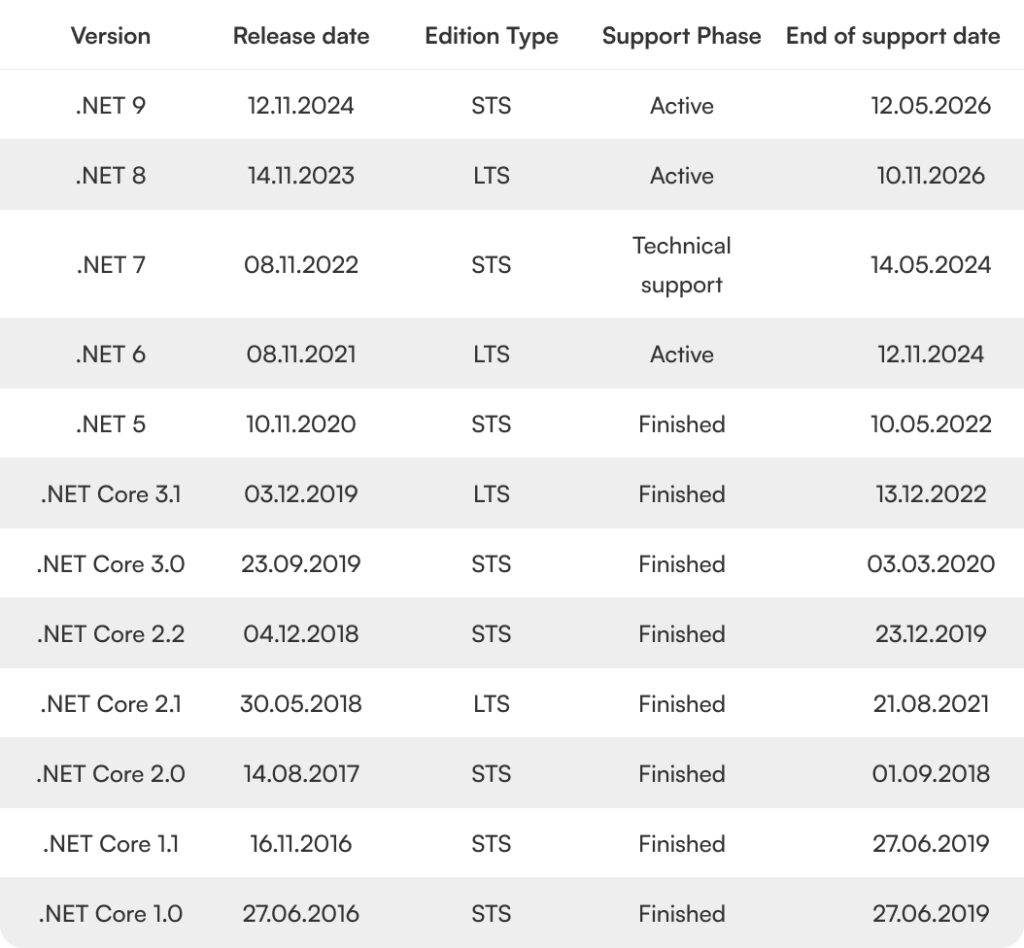If you’re considering modernizing your system and migrating from an older version of .NET to a newer one but keep putting it off, this article is for you. Software migration is a typical task in the “important but not urgent” category – the current system still works. However, over time, the problem only grows, and the lack of action can turn into a major challenge that will be costly and complex to solve.
Why is it worth addressing technical debt now, and how should you approach migration? Read on to learn more.
What does “old .NET” mean?
“Old .NET” primarily refers to earlier versions, particularly the classic .NET Framework, which ran exclusively on Windows Server. All versions earlier than .NET Framework 4.8.1 are no longer supported by Microsoft and are considered obsolete. .NET Core was a transitional version that allowed .NET to run on other systems, including the now-popular Linux. The most well-known version of Core was 3.1, but its support ended in 2022. Starting with .NET 5, the features of the old .NET Framework and Core were combined into one modern platform. The latest version is .NET 9, which runs on various operating systems.
Which version should you choose?
There are long-term supported versions (LTS) like .NET 6 and .NET 8, which are recommended for projects requiring long-term stability. On the other hand, short-term supported versions (STS) like .NET 5, .NET 7, and .NET 9 have shorter support periods – ideal for deploying new features but less suitable for long-term projects. However, migrating from odd-numbered to even-numbered .NET versions is very easy and fast, making it worth keeping your .NET version up to date.
For critical systems where the risk of downtime or errors is high, the migration can be done in stages, rewriting the system module by module.
What risks do you face if you don’t rewrite the legacy system to a new version?
Working with an older version of .NET may seem fine since the system is still running. However, every technological solution becomes outdated over time and carries a range of disadvantages that can affect your business operations.
Failing to migrate from old .NET to the latest version poses serious risks that can significantly impact the functioning and competitiveness of your company. Here are the key threats:
1. Dependency on a small group of specialists
When a few key employees are responsible for maintaining an outdated system, all knowledge about it is concentrated in their hands. If these specialists are the only ones who fully understand the system’s architecture, business logic, and specifics, the company becomes entirely dependent on them. If one decides to leave, retire, or becomes unavailable for other reasons (e.g., health issues), it can cause significant operational problems. In this scenario, the company is left without this knowledge, making repairs, development, or even ongoing technical support difficult. Even minor issues that could be quickly addressed by someone familiar with the system may turn into major downtime, generating additional costs and customer dissatisfaction. Recruiting new specialists skilled in working with old .NET is becoming increasingly difficult as fewer people are familiar with these technologies and want to work with older versions of .NET.
2. Rising maintenance costs
Maintaining systems based on older versions of .NET becomes increasingly expensive and time-consuming. Over the years, the number of problems requiring manual intervention grows, and the availability of specialists decreases. As a result, the company invests significant resources in repairs and servicing, which may exceed the cost of migrating to modern solutions. In older systems, where quick fixes have been applied over the years, the code structure often resembles “spaghetti” – full of connections that are hard to identify and control. Any change can affect other unpredictable parts of the system, making development and modifications difficult. The lack of ongoing refactoring makes the code harder to read and more error-prone, and implementing new design patterns becomes challenging.
3. Increased vulnerability to cyberattacks and failures
Microsoft has ended technical support for older versions of .NET Framework, meaning these systems no longer receive security updates or patches. In practice, the lack of support exposes systems based on these versions to increased risk of cyberattacks and failures. As new security vulnerabilities are discovered, unsupported systems can become susceptible to data breaches, leading not only to potential financial losses but also a loss of customer trust. Updating to newer versions not only improves security but also boosts performance, especially in migration from .NET Framework to modern .NET Core or .NET 5+, enabling the use of more efficient runtime environments such as containers instead of traditional Windows servers.
Check your .NET version and see if it’s still supported

Dependency on Windows
Older versions of .NET (e.g., .NET Framework) only work on Windows Server, making your company dependent on a single server software provider – Microsoft. This licensing model can be expensive and limits flexibility in choosing cheaper and more efficient server solutions, such as Linux. Windows Server often has low performance, especially under heavy load, which can lead to increased operational costs. Newer versions like .NET Core and .NET 6+ fully support Linux, opening up new possibilities for your company by enabling the use of more efficient and flexible server solutions.
What will you gain by migrating to the new .NET?
Migrating to the latest version of .NET is a strategic investment that brings numerous benefits:
1. Higher performance and stability
Newer versions of .NET run faster and consume fewer resources. Microsoft’s research has shown that applications from .NET 6 onwards can handle up to 60% more requests at the same server load. For example, Stack Overflow, after migrating to the latest .NET version, reduced CPU usage by 25% and observed faster page load times. Better stability leads to fewer downtimes, improving user experience. Additionally, migration to Linux systems reduces cloud hosting costs and eliminates licensing fees since Linux is open-source.
2. Access to modern cloud solutions
Migrating to the new .NET is a key step toward modernity and long-term growth. New versions of .NET ensure stability and performance, meaning fewer updates and less downtime. They also open the door to collaboration with new technologies like Azure Functions, which allow for flexible cloud code execution without managing infrastructure. This enables you to quickly respond to changing business needs and easily integrate new features. Investing in modern solutions like new .NET ensures long-term effectiveness and security in a dynamically changing environment.
3. Increased team engagement and stability
By investing in modern technologies like .NET 6+, you create an attractive work environment that increases the value of your IT team in the job market. By working with the latest tools, specialists acquire new, valuable skills, strengthening their job stability and loyalty to your company. This reduces the risk of employee turnover, improving team stability and reducing costs associated with employee rotation.
Common concerns about taking the first step
Any significant change comes with some uncertainty. Even if you believe that system migration is necessary, various concerns may prevent you from taking the first step. Common thoughts include:
1. “What will happen to the current IT team?”
You might worry that migrating to new technologies will require replacing the team, or whether the current specialists who have supported the old system for years will be able to handle the new one. However, it’s worth looking at migration as an opportunity, not a threat, for both the company and the team. Existing employees provide invaluable knowledge of the system, business logic, and code structure. However, to ensure smooth migration, it’s beneficial to work with a partner specializing in migrating to newer .NET versions. This is also an opportunity for your in-house development team to learn best practices from external consultants familiar with the newer .NET versions.
2. The cost of migration will be too high
Uncertainty about migration costs can hold you back from making the first step. This is why a detailed project audit is key before migrating – it allows you to estimate the full costs and benefits of rewriting the system, determining whether the investment is worthwhile and in what form it should be carried out. If the current system is stable and well-designed, you could consider migrating in stages. A microservices architecture allows for gradual migration of modules, which not only spreads costs over time but also reduces technical risks. This phased process allows you to monitor expenses in real-time and better adapt to any challenges, making migration less financially burdensome and safer for the organization.
See what the migration of an old system looks like in practice.
See case study3. The old system works – concerns about errors in the new system
A significant concern with migration is the risk that the newly rewritten system will contain errors, leading to downtime and generating unforeseen costs. The thought of potential bugs in the new environment may make maintaining the old, albeit costly, system seem safer – after all, “the current system is old, expensive, but at least it works.” However, it’s important to note that outdated technology also carries risks, especially in the long run. Migration, if planned and carried out in stages (e.g., using a microservices architecture), allows for gradual implementation of new solutions, reducing the chances of major errors and enabling quick responses in case of issues.
Conclusion
Migrating older versions of .NET to modern solutions is a step that brings many benefits, including increased security, higher performance, and technological flexibility. Migration eliminates the risks associated with maintaining unsupported systems and reduces operational costs by enabling the use of more efficient server solutions. It also makes it easier to recruit new specialists and improves team engagement by working with modern tools. Embracing this approach also means long-term benefits, stability, and better preparation for future technological changes.







